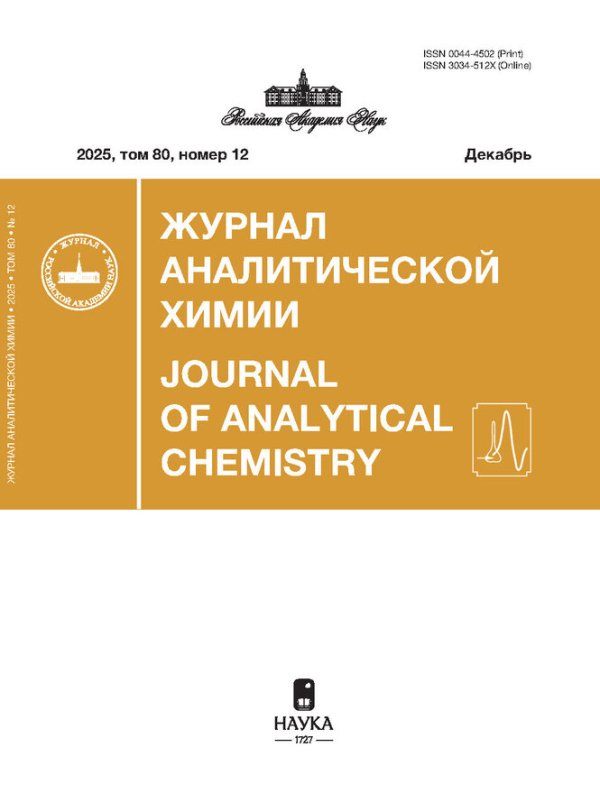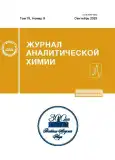Vol 78, No 9 (2023)
REVIEWS
Isolation of Nanoparticles from Soil and Dust and Their Study by Single Particle Inductively Coupled Plasma Mass Spectrometry
Abstract
The study of natural and anthropogenic dust and soil nanoparticles is an urgent task of analytical chemistry and biogeochemistry, the solution of which requires the use of complementary separation and analysis methods. In this work, the existing approaches to the isolation of nanoparticles from natural polydisperse samples are summarized. Methods of extracting nanoparticles with aqueous solutions, a possibility of intensifying the process of extracting nanoparticles by an ultrasonic field, methods of cloud-point extraction, and also methods for purifying the separated fractions of nanoparticles from impurities of microparticles are considered. The advantages and disadvantages of these methods are evaluated. It is noted that the success of a study of soil and dust nanoparticles depends on the competent choice of a set of methods for isolating nanoparticles from polydisperse samples and their purification from microparticle impurities, as well as methods for the characterization and elemental analysis of nanoparticles. Particular attention is paid to single particle inductively coupled plasma mass spectrometry as a promising method for determining the concentration, size distribution, and elemental composition of nanoparticles.
 771-782
771-782


Singly Charged Argide ArM+ Ions in Inductively Coupled Plasma–Mass Spectrometry
Abstract
Singly charged argide ArM+ ions in inductively coupled plasma–mass spectrometry (ICP–MS) can cause significant spectral interferences in the determination of all elements of the Periodic Table of the Elements with atomic numbers above 36 and measurements of their isotopic composition. This review presents examples of the such characteristic interferences and respective recommended and used interference tables for different elements. Published data on the determination of the dissociation energies of ArM+ ions by experimental and theoretical methods are summarized. The relationship between the dissociation energies of argide ions and their intensities in the mass spectrum is discussed. The experimental determination of the numerical values of the interference level ArM+/M+ in ICP–MS and the influence of various instrumental and operation parameters on this ratio are considered. The main options for the account and reduction of the effect of ArM+ in the mass spectra or elimination of the interference of argide ions are presented. A conclusion and recommendations on the considered publications are made.
 783-806
783-806


ORIGINAL ARTICLES
Selective Adsorbents Based on Imprinted Glucose Oxidase
Abstract
A procedure for the synthesis of a highly selective adsorbent based on an imprinted protein (IP), glucose oxidase (GO), and commercially available SiO2 microparticles for the sorption of mycotoxin zearalenone produced by fungi of the Fusarium species is developed. The use of 3D fluorescence spectroscopy for the control of the process of IP purification is proposed for the first time. A possibility of replacing the zearalenone molecule as a template molecule with structural analogues with lower toxicity is assessed. The analytical characteristics of the determination of zearalenone using imprinted GO as a receptor element in enzyme immunoassay are determined: the limit of detection is 5 ng/mL, the linear analytical range is 11–112 ng/mL. High sorption characteristics of the synthesized adsorbent based on IP (sorption capacity—7.6 μg/mg sorbent; imprinting factor—2.5) are shown.
 807-812
807-812


Rapid Colorimetric Determination of Biologically Active Organic Analytes
Abstract
Four types of reactions (azo coupling, protolytic and oxidative condensation, ion association), accompanied by the formation of hydrophobic colored analytical forms of corresponding organic analytes, are proposed on an example of biologically active substances (aromatic amines, α-amino acids, antibiotics of aminoglycoside and β-lactam series, anionic surfactants). It is shown that, in these systems, the hydrophobicity of both the initial reactants, e.g., tetrafluoroborates of diazonium salts, and analytical forms (azo compounds, Schiff bases, Ruemann’s purpura, ion associates with surfactants) can be increased. Possibilities of various methods for the derivatization of organic analytes with the formation of colored analytical forms with increased hydrophobicity for the best fixation on solid matrices and the development of test systems on their basis, which can be used to control the quality of various samples with rather good performance characteristics, are considered.
 813-820
813-820


QuEChERS Extraction of PAHs from Various Soils and Sediments Followed by Chromatographic Determination
Abstract
We studied the features of PAHs extraction by QuEChERS in the sample preparation of soils and bottom sediments of various compositions followed their determination by gas chromatography–mass-spectrometry. The test samples were soils of sandy, loamy sand, loamy, and clayey types and bottom sediments of loamy sand type. The mineralogical composition and organic matter content of the samples were used to predict how PAHs were retained by the soils and sediments. The impact of ultrasonic treatment on analyte extraction with subsequent identification by chromatography was assessed. No ultrasonic treatment was required to extract and determine all PAHs (up to 100%) in sandy and loamy sand soils and low-molecular-weight PAHs in all test samples. The QuEChERS extraction and determination of high-molecular-weight PAHs in clay type soil samples and loamy sand bottom sediments required a 10-min ultrasonic treatment, while the recoveries of analytes were higher than 87 and 90%, respectively. The analysis of a loamy soil sample with a high organic matter content was the most challenging. To extract over 70% of high-molecular-weight PAHs from a sample of this type using the QuEChERS technique, the binary acetonitrile–acetone (1 : 1) extractant rather than conventional acetonitrile was used with the simultaneous 15-min ultrasonic treatment.
 821-836
821-836


Comparative Analysis of Chemical Compositions of Mentha L. Plant Extracts by Gas Chromatography–Mass Spectrometry after Hydrodistillation and Subcritical Extraction
Abstract
The results of a study of the composition of essential oil and extracts obtained by hydrodistillation and subcritical extraction from plants of the genus Mentha L. are presented. The test samples were peppermint (Mentha piperita L.) and horsemint (Mentha longifolia L.). Gas chromatography–mass spectrometry was used to identify and compare the component composition of essential oils and extracts from Mentha L. plants. The composition of the essential oil of horsemint differs from the essential oil of peppermint by the high concentration of linalool and the absence of pulegone and piperitone. The component composition of the extracts of peppermint and horsemint, obtained under conditions of subcritical extraction with water and acetone, was studied. The concentration of monoterpenes, sesquiterpenes, and esters increased in the transition from the essential oil to the acetone subcritical extract of both types of mint. In the water extract of peppermint, there were practically no sesquiterpenoids or esters; there was a general decrease in the yield of all components compared to the essential oil and acetone extract.
 837-847
837-847


Effects of Comorbidities on the Profile of Volatile Organic Compounds in the Exhaled Breath of Lung Cancer Patients
Abstract
The diagnostics of lung cancer by exhaled breath is a promising field in medicine; however, many patients with lung cancer have other concomitant diseases that could impact the accuracy of diagnostic techniques. This work is devoted to a GC–MS study of possible effects of the most common comorbidities: chronic heart failure, hypertension, obesity, diabetes mellitus, and atherosclerosis on the composition of volatile organic compounds in the exhaled breath of patients with lung cancer. Components and their ratios, which were different in groups of patients with lung cancer and diverse concomitant diseases, were found.
 848-855
848-855


Determination of Umifenovir and Its Metabolites by High-Performance Liquid Chromatography with Combined Mass Spectrometric Detection
Abstract
An approach to the highly sensitive and selective determination of the bromine-containing antiviral drug umifenovir (Arbidol) and its metabolites in natural and waste water, activated sludge, and bottom sediments by chromatography-mass spectrometry based on a combination of two techniques– inductively coupled plasma mass spectrometry (ICP MS) and electrospray ionization high-resolution mass spectrometry (ESI HRMS) is developed. Reversed-phase chromatographic separation and detection based on ESI HRMS provide the reliable detection and identification of analytes in complex matrices, while the use of ICP-MS with 79Br signal detection makes it possible to exclude matrix effects and use a single analytical standard for quantitative analysis. The use of solid-phase extraction and pressurized liquid extraction as sample preparation methods made it possible to achieve limits of detection at a level of 0.2 ng/L and 2 µg/kg for liquid and solid samples, respectively. The developed approach was successfully tested in the analysis of real samples. It is shown that the concentrations of analytes in urban wastewaters are in the range 4.4–260 ng/L. The highest concentration (up to 3.7 mg/kg) is characteristic of activated sludge, which acts as an effective sorbent for umifenovir and its transformation products.
 856-864
856-864













